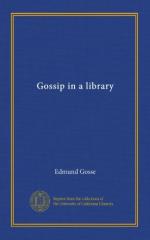Much of the latter part of the Diary, as we hold it, is occupied with the description of a tour in England and Wales. Here Green is lucid, graceful, and refined: producing one after another little vignettes in prose, which remind us of the simple drawings of the water-colour masters of the age, of Girtin or Cozens or Glover. The volume, which opened with some remarks on Sir William Temple, closes with a disquisition on Warton’s criticism of the poets. The curtain rises for three years on a smooth stream of intellectual reflection, unruffled by outward incident, and then falls again before we are weary of the monotonous flow of undiluted criticism. The Diary of a Lover of Literature is at once the pleasing record of a cultivated mind, and a monument to a species of existence that is as obsolete as nankeen breeches or a tie-wig.
Isaac D’Israeli said that Green had humbled all modern authors to the dust, and that he earnestly wished for a dozen volumes of The Diary. At Green’s death material for at least so many supplements were placed in the hands of John Mitford, who did not venture to produce them. From January 1834 to May 1843, however, Mitford was incessantly contributing to The Gentleman’s Magazine unpublished extracts from this larger Diary. These have never been collected, but my friend, Mr. W. Aldis Wright, possesses a very interesting volume, into which the whole mass of them has been carefully and consecutively pasted, with copious illustrative matter, by the hand of Edward FitzGerald, whose interest in and curiosity about Thomas Green were unflagging.
PETER BELL AND HIS TORMENTORS
PETER BELL: A Tale in Verse, by William Wordsworth. London: Printed by Strahan and Spottiswoode, Printers-Street: for Longman, Hurst, Rees, Orme and Brown, Paternoster Row. 1819.
None of Wordsworth’s productions are better known by name than Peter Bell, and yet few, probably, are less familiar, even to convinced Wordsworthians. The poet’s biographers and critics have commonly shirked the responsibility of discussing this poem, and when the Primrose stanza has been quoted, and the Parlour stanza smiled at, there is usually no more said about Peter Bell. A puzzling obscurity hangs around its history. We have no positive knowledge why its publication was so long delayed; nor, having been delayed, why it was at length determined upon. Yet a knowledge of this poem is not merely an important, but, to a thoughtful critic, an essential element in the comprehension of Wordsworth’s poetry. No one who examines that body of literature with sympathetic attention should be content to overlook the piece in which Wordsworth’s theories are pushed to their furthest extremity.
When Peter Bell was published in April 1819, the author remarked that it had “nearly survived its minority; for it saw the light in the summer of 1798.” It was therefore composed at Alfoxden, that plain stone house in West Somersetshire, which Dorothy and William Wordsworth rented for the sum of L23 for one year, the rent covering the use of “a large park, with seventy head of deer.”




